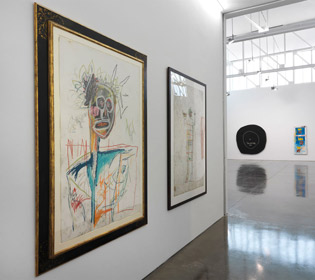SAMO, meaning same old, was Jean-Michel Basquiat’s tag name at the beginning of his artistic career, but Basquiat was far from the same old before him. He created his own space in art in the 1980s when the art market was at its height.

In honor of his work, the Gagosian Gallery in New York City decided to feature Basquiat in an exhibit simply titled, “Jean-Michel Basquiat.” The exhibit, which runs until Apr. 6, features 59 of Basquiat’s paintings from public and private collections that span his entire artistic career. Gagosian Galleries across the world have featured Basquiat’s work in nine other exhibits since 1997. However, this is the first exhibit to exclusively present his paintings alone.
Basquiat, who was born in New York City in 1980 to a Haitian father and a Puerto Rican mother, began his career in art at age three. He created cartoon-like characters based off of Alfred Hitchcock films and Alfred E. Newman’s character in Mad. He entered in the graffiti phase of his career when he transferred to the City-As-School, where he developed the pseudonym SAMO. There he met Al Diaz, a graffitist from the Jacob Riis Projects, who later became his collaborator.
“His best paintings maintain a powerful tension between opposing aesthetic forces—expression and knowledge, control and spontaneity, savagery and wit, urbanity and primitivism,” according to a statement by Gagosian Gallery, “while providing [blunt] commentary on the harsher realities of race, culture, and society.”
Basquiat’s works were featured in “New York/New Wave”, an exhibition organized by Diego Cortez in Long Island City, with fellow artists Andy Warhol and Keith Haring. To Basquiat this was the moment where he could attest he made it. After that exhibit Basquiat’s works were featured in art galleries from Los Angeles to West Germany to Zurich. His Aztec cave-like drawings, painted in primary colors using acrylics, oils and paint sticks, which depicted his inner rage became the it art. He was praised as revolutionary and achieved the success he desired to prove to his father.
Although Basquiat had continued to be the master of the underground scene, it wasn’t until his break in 1980 he began to feel the burn of fame. The demons he painted were too real for him. In 1988 he died of a drug overdose at 27 years old. His last show was featured in the Mary Boone Gallery, New York, in 1986.
“From the outset he worked compulsively,” Gagosian Gallery said. “Charismatic image aside, Basquiat was a unique and prodigious artistic talent, fusing drawing and painting with history and poetry to produce an artistic language and content that was entirely his own.”
Filed Under :













